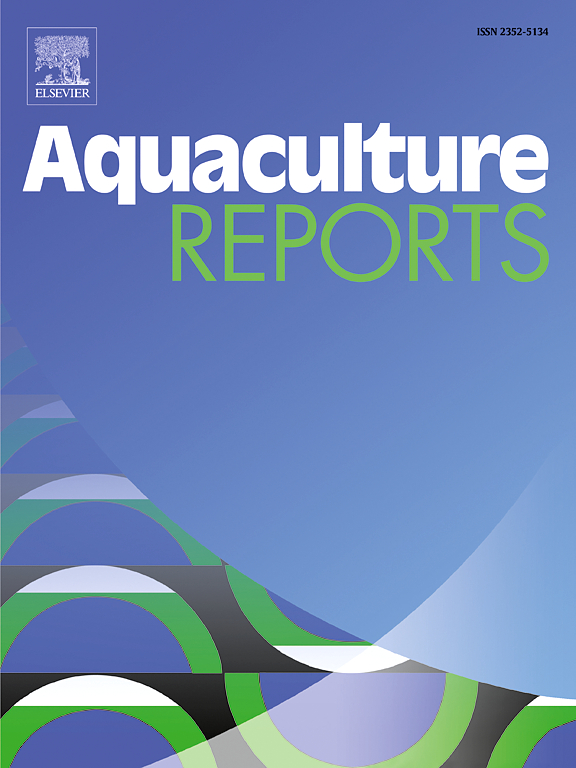Effects of replacing fish oil with shrimp waste, canola, and camelina oils on growth and fillet lipid quality in juvenile rainbow trout fed low-fishmeal diets
IF 3.2
2区 农林科学
Q1 FISHERIES
引用次数: 0
Abstract
This study assessed the replacement of fish oil (FO) with camelina oil, canola oil, and Argentinian marine shrimp oil (from industry waste) in juvenile rainbow trout (Oncorhynchus mykiss) diets. Fish (initial weight 7.97 ± 0.83 g) were distributed into eighteen 100-liter tanks (36 fish per tank; initial density ∼2.9 kg/m³) and fed six experimental diets for 60 days at 3 % body weight per day. The diets were isonitrogenous (52 % crude protein) and isolipidic (21–22 % lipids). The experimental diets were FO (100 % fish oil), SH (100 % shrimp oil), SHCA (75 % canola + 25 % shrimp oil), COCA (75 % canola + 25 % camelina oil), CO (100 % camelina oil), and CA (100 % canola oil). Growth performance showed comparable outcomes across treatments. Whole-body proximal composition revealed stable dry matter content (96.05 % FO to 97.56 % SHCA) and protein content (50.25 % CO to 52.92 % FO). Lipid content was higher in SHCA (37.36 %) and COCA (37.28 %) diets, while FO (35.03 %) and SH (34.63 %) diets had lower levels. Protein was most digestible in FO (92.6 ± 0.56 %) and SHCA (92.5 ± 0.58 %) diets. Phosphorus digestibility was highest in SH-fed fish (69.7 ± 2.24 %). Fatty acid profiles showed higher saturated fatty acids (SFA) in FO and SH (33.43 and 27.36 mg g⁻¹, respectively) and long-chain omega-3s (EPA and DHA) in FO. CO and CA diets were rich in monounsaturated fatty acids (MUFA), with CA having 57.59 mg g⁻¹ . Fillet nutritional quality indices showed that FO (0.602 ± 0.005) and SH (0.586 ± 0.105) had the highest atherogenicity index and more favorable omega-6/omega-3 ratios (SH: 0.230 ± 0.023, FO: 0.267 ± 0.023).
用虾渣、菜籽油和亚麻荠籽油替代鱼油对低鱼粉饲料中虹鳟幼鱼生长和鱼片脂质的影响
本研究评估了用亚麻荠籽油、菜籽油和阿根廷海洋虾油(来自工业废料)替代虹鳟幼鱼饲料中的鱼油(FO)。鱼(初始重量7.97 ± 0.83 g)被分配到18个100升的鱼缸中(每个鱼缸36条鱼;初始密度~ 2.9 kg/m³),以3 %体重/天饲喂6种试验饲粮60天。饲粮为等氮(52 %粗蛋白质)和等脂(21-22 %脂)。试验饲粮为鱼油(100% %鱼油)、SH(100 %虾油)、SHCA(75 %菜籽油+ 25 %虾油)、COCA(75 %菜籽油+ 25 %亚麻荠油)、CO(100 %亚麻荠油)和CA(100 %菜籽油)。不同处理的生长表现具有可比性。全身近端成分显示干物质含量(96.05 % FO ~ 97.56 % SHCA)和蛋白质含量(50.25 % CO ~ 52.92 % FO)稳定。油脂含量在SHCA(37.36 %)和COCA(37.28 %)饲粮中较高,而FO(35.03 %)和SH(34.63 %)饲粮中较低。蛋白质在鱼油(92.6 ± 0.56 %)和鲜鱼油(92.5 ± 0.58 %)饲粮中消化率最高。sh饲料鱼的磷消化率最高(69.7 ± 2.24 %)。脂肪酸谱显示,鱼油和鱼油的饱和脂肪酸(SFA)较高(分别为33.43和27.36 mg g⁻¹),鱼油的长链omega-3s (EPA和DHA)含量较高。CO和CA的饮食富含单不饱和脂肪酸(MUFA), CA的含量为57.59 mg g⁻¹ 。鱼片营养品质指标显示,鱼油(0.602 ± 0.005)和鱼油(0.586 ± 0.105)具有最高的动脉粥样硬化指数和更有利的ω -6/ ω -3比值(鱼油:0.230 ± 0.023,鱼油:0.267 ± 0.023)。
本文章由计算机程序翻译,如有差异,请以英文原文为准。
求助全文
约1分钟内获得全文
求助全文
来源期刊

Aquaculture Reports
Agricultural and Biological Sciences-Animal Science and Zoology
CiteScore
5.90
自引率
8.10%
发文量
469
审稿时长
77 days
期刊介绍:
Aquaculture Reports will publish original research papers and reviews documenting outstanding science with a regional context and focus, answering the need for high quality information on novel species, systems and regions in emerging areas of aquaculture research and development, such as integrated multi-trophic aquaculture, urban aquaculture, ornamental, unfed aquaculture, offshore aquaculture and others. Papers having industry research as priority and encompassing product development research or current industry practice are encouraged.
 求助内容:
求助内容: 应助结果提醒方式:
应助结果提醒方式:


